Building
The New Museum opened its current, seven-story building designed by Pritzker Architecture Prize-winning firm SANAA / Kazuyo Sejima and Ryue Nishizawa in 2007 on the Bowery at the terminus of Prince Street in New York City. In November 2022, the New Museum broke ground on a 60,000-square-foot expansion designed by OMA / Shohei Shigematsu and Rem Koolhaas. This new structure will complement and be seamlessly integrated with the Museum’s SANAA-designed flagship building while doubling our exhibition space, creating new venues for artist residencies and public programs, and establishing a permanent home for our cultural incubator NEW INC. To learn more about the Museum’s planned expansion, please click here.
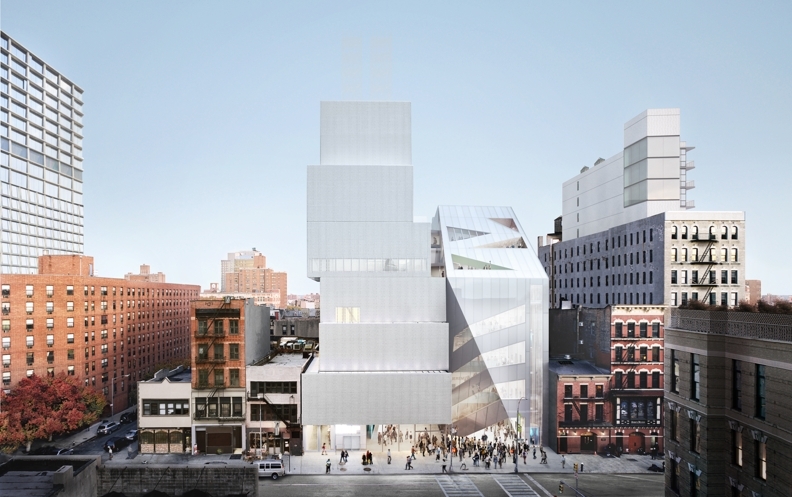 Street Views of the New Museum at 235 Bowery
Street Views of the New Museum at 235 Bowery
History of the New Museum at 235 Bowery
SANAA was named one of “The World’s 50 Most Innovative Companies” by Fast Company in 2016.
The New Museum building is intended as a home for contemporary art and an incubator for new ideas, as well as an architectural contribution to New York’s urban landscape. Sejima and Nishizawa, who received the commission for the Museum’s current flagship building in 2002, have described the project as their response to the history and powerful personalities of both the New Museum and its storied site. “The Bowery was very gritty when we first visited it,” they have said. “We were a bit shocked, but we were also impressed that a fine art museum wanted to be there. In the end, the Bowery and the New Museum have a lot in common. Both have a history of being very accepting, open, embracing of every idiosyncrasy in an unprejudiced manner. When we learned about the history of the New Museum we were flabbergasted by its attitude, which is very political, very focused on new ideas, fearless. The New Museum is a combination of elegant and urban. We were determined to make a building that felt like that.” Amidst a cluster of relatively small and mid-sized buildings of varying types and uses, the New Museum rises 175 feet above street level. As visitors approach on the Bowery or from the west along Prince Street, they encounter the building as a dramatic stack of seven rectangular boxes.
This distinctive form derives directly from the architects’ defining solution to fundamental challenges of their site. They arrived at a dense and ambitious program that would allow for open, flexible gallery spaces of different heights and atmospheres within a tight zoning envelope on a footprint a mere seventy-one feet wide and 112-feet deep.
In order to address these conditions without creating a monolithic, dark, and airless building, SANAA assigned key programmatic elements to a series of levels (the seven boxes), stacked those boxes according to the anticipated needs and circulation patterns of building users, then drew the different levels away from the vertebrae of the building core laterally to the north, south, east, or west. The shifted-box approach yields a variety of open, fluid, and light-filled internal spaces that are different heights at every level, with different characters but all column-free.
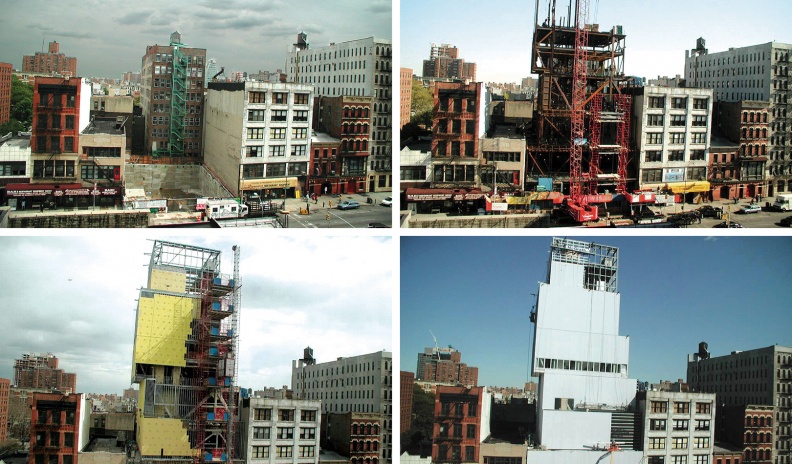 The New Museum at 235 Bowery under construction
The New Museum at 235 Bowery under construction
The New Museum is clad in a seamless, anodized expanded aluminum mesh chosen by SANAA to emphasize the volumes of the boxes while dressing the whole of the building like a strong body in a delicate, filmy, softly shimmering skin. With windows just visible behind this porous scrim-like surface (achieved with a common material never before employed to clad major a building façade), the structure appears as a single, coherent, and even heroic form that is nevertheless mutable, dynamic, and animated by the changing light of day—an appropriate visual metaphor for the openness of the New Museum and the ever-changing nature of contemporary art. “It was complicated to organize the architecture around all of the desires,” Sejima and Nishizawa have said. “We knew we could not maximize the entire site with solid architecture, we had to reduce the building’s mass somehow to create space between it and the perimeter. The solution of the shifted boxes arrived quickly and intuitively. Then through trial and error we arrived at the final, ideal configuration. Now we have a building that meets the city, allows natural light inside, gives the Museum column-free galleries and programmatic flexibility, and expresses the program and people inside to the world of New York outside.”
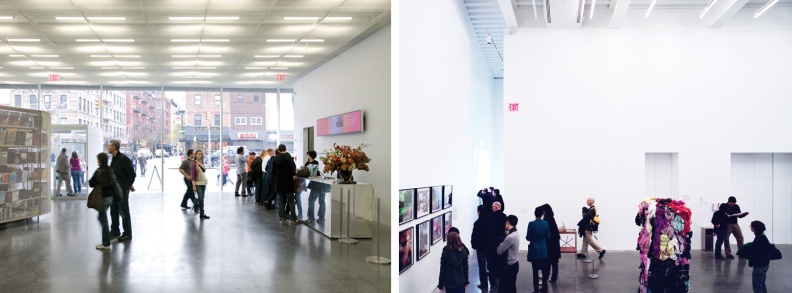 Views of the Lobby and Fourth Floor
Views of the Lobby and Fourth Floor
From the Street to the Art
Visitors are drawn into the New Museum by views through a nearly fifteen-foot-tall plane of clear plate glass along the Bowery, stretching across the full width of the site to include both the public entrance and the entrance to the Museum’s loading dock, on the north side of the core, where back-of-house activities and the movement of artworks are on full view to passersby. Through this clear membrane, visitors see all of various functions of the lobby level, a transitional space between the life of the street and that of the Museum. The color and buzz of the Bowery neighborhood give way here to a luminous, pale space, full of daylight washing a palette of white and silver.
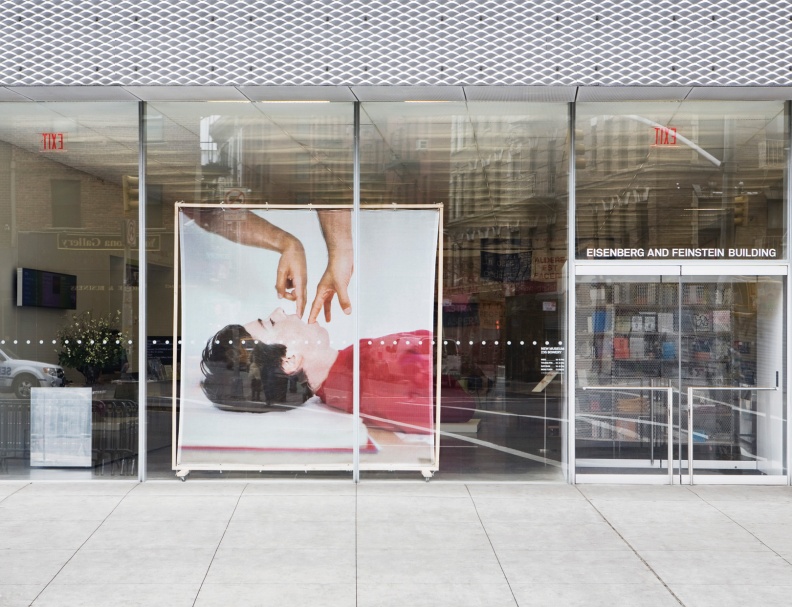 View looking into the New Museum from the Bowery
View looking into the New Museum from the Bowery
“We wanted to make interiors that expose the way they work in a ‘beautiful rough’ way that is appropriate to the Museum and right for the budget and the place,” Sejima and Nishizawa have stated. “We don’t want to hide things behind gyp board, we want to show what the building is made of and maximize the feeling of openness, but do it in a beautiful way inside the parameters of the toughness. This is why the building’s structure and guts are exposed—the ducts, the sprinklers, the fireproofing material—and the view from the street includes everything on the ground floor.”
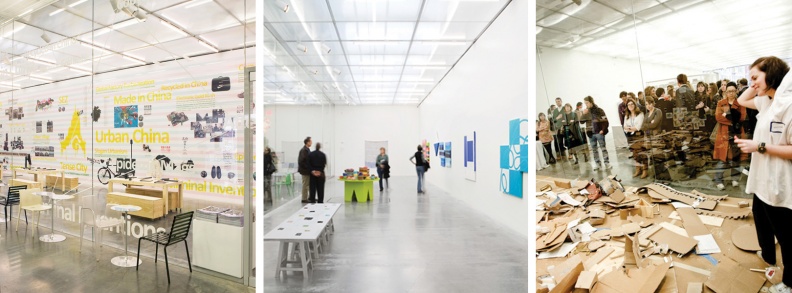 Installation views from the Lobby Gallery. From the far left: “The Three M Project: New Commissions: Urban China: Informal Cities” (2009); “Mary Heilmann: To Be Someone” (2008–09); and “The Generational: Younger Than Jesus” (2009)
Installation views from the Lobby Gallery. From the far left: “The Three M Project: New Commissions: Urban China: Informal Cities” (2009); “Mary Heilmann: To Be Someone” (2008–09); and “The Generational: Younger Than Jesus” (2009)
Gray concrete sidewalk outside gives way to polished gray concrete floors in the grand but intimate Marcia Tucker Hall. This space contains the Visitor Services desk, ticketing desk, Coat Check, the New Museum Store (demarcated by a serpentine screen of metal mesh), the New Museum café and its open kitchen, the stairway down to the building’s lower level and Theater, elevator banks for access to the galleries above, and a luminous 1,100-square-foot gallery separated from the rest of the space by a soaring glass wall and illuminated by daylight filtering down from the shift of the structural box above. A floating dropped screen of metal mesh softens and abstracts the largely visible functions of the ceiling above it, filtering light from a grid of glowing, petite florescent tubes.
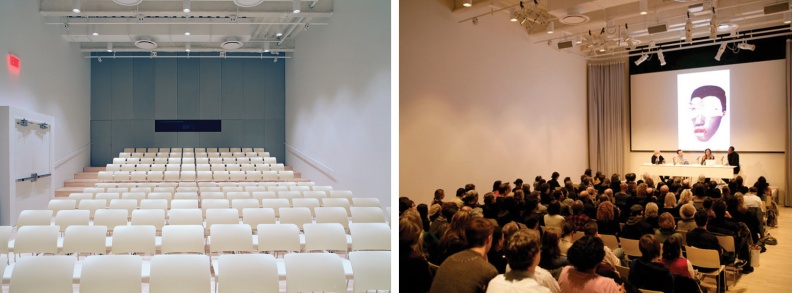 From left: White-box theater; theater in use during a public program.
From left: White-box theater; theater in use during a public program.
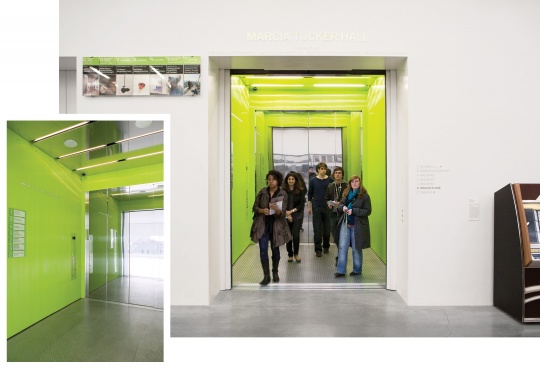 Descending by either the open, glass-enclosed interior stairway or an elevator to the building’s lower level, visitors will find a 182-seat “white box” theater/auditorium and a pre-function hall that doubles as a gallery for special projects and installations. This floor also houses the Museum’s restrooms (where Bisazza tile super-graphics cover walls with hotly hued, pixilated hanimi cherry blossom patterns—the only intensely colored feature in the building aside from the vibrant green elevator cab interiors); backstage support, storage, and green room areas for the theater; general storage; and mechanical support.
Descending by either the open, glass-enclosed interior stairway or an elevator to the building’s lower level, visitors will find a 182-seat “white box” theater/auditorium and a pre-function hall that doubles as a gallery for special projects and installations. This floor also houses the Museum’s restrooms (where Bisazza tile super-graphics cover walls with hotly hued, pixilated hanimi cherry blossom patterns—the only intensely colored feature in the building aside from the vibrant green elevator cab interiors); backstage support, storage, and green room areas for the theater; general storage; and mechanical support.
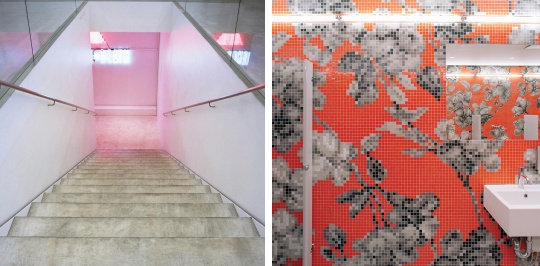 “A museum for contemporary art should be neutral in the character of its gallery spaces, in order to create the widest palette for the art itself,” SANAA has stated. “With the galleries in this building, we tried to play with dimensions and the way daylight falls in the spaces. This allows the visitor to experience art in slightly different conditions on different visits, at different times of the day, in different spaces, without impeding the qualities of the art.”
“A museum for contemporary art should be neutral in the character of its gallery spaces, in order to create the widest palette for the art itself,” SANAA has stated. “With the galleries in this building, we tried to play with dimensions and the way daylight falls in the spaces. This allows the visitor to experience art in slightly different conditions on different visits, at different times of the day, in different spaces, without impeding the qualities of the art.”
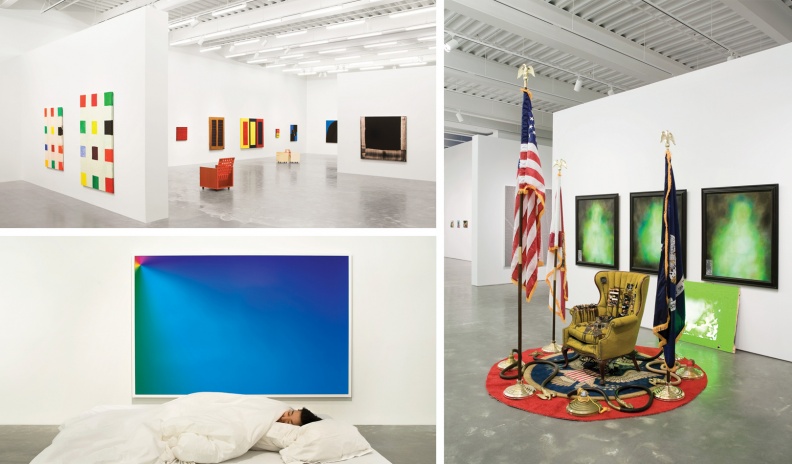 Top left: ‘Mary Heilmann: To Be Someone” (2008–09); Bottom left and right: “The Generational: Younger Than Jesus” (2009)
Top left: ‘Mary Heilmann: To Be Someone” (2008–09); Bottom left and right: “The Generational: Younger Than Jesus” (2009)
The Second Floor provides approximately 5,000 square feet of exhibition space with ceilings eighteen feet high, skylights tracing the west and north walls of the building, and concrete floors that appear to float via a carefully crafted reveal that runs the full perimeter of the space where the floor meets the walls. The shifting of the structural box at this level has created an additional, quiet, and unique gallery space—ten feet wide and forty feet long, accessed from either end of the main gallery—on the north side of the core.
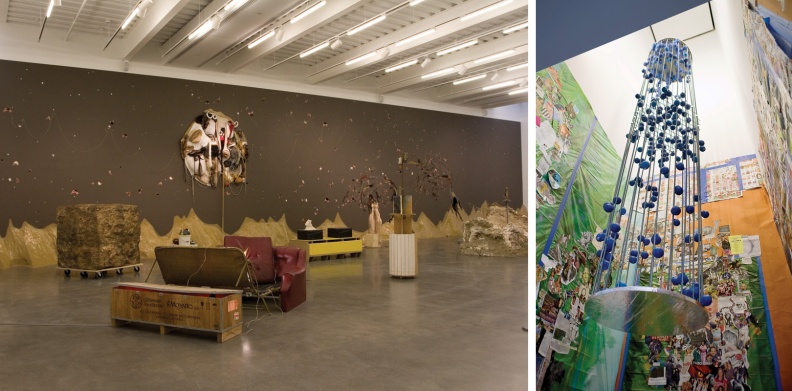 Left: “Unmonumental” (2007–08) installed in the Third Floor gallery; Right: “Agathe Snow: Master Bait Me” (2009) installed in the Shaft Space
Left: “Unmonumental” (2007–08) installed in the Third Floor gallery; Right: “Agathe Snow: Master Bait Me” (2009) installed in the Shaft Space
The Third Floor gallery, with approximately 4,000 square feet of exhibition space, boasts a ceiling height of twenty-one feet with east and west skylights. On this floor, visitors find the entrance to an exquisite open stairway running fifty feet upward along the building’s north side. Off a landing on this flight of stairs is one of the building’s most eccentric spaces: the Shaft Space. Five feet by eight feet, and thirty-five feet tall, it was formed from structural shift between the third and fourth floors. The New Museum commissions site-specific installations to occupy the space.
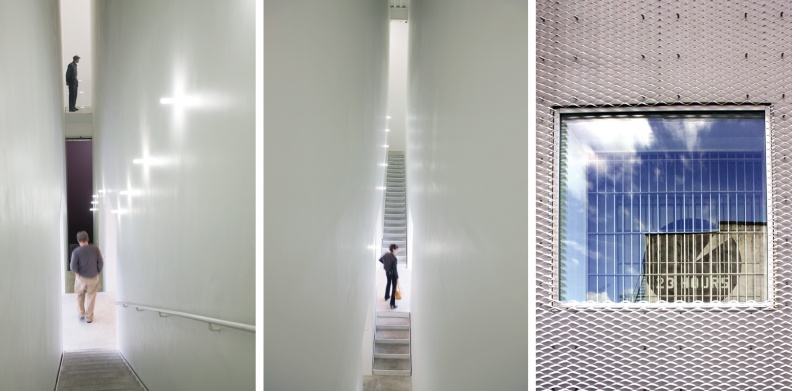 Stairwell between Third and Fourth Floors. Latter: Installation view of “Rigo 23: The Deeper They Bury Me, The Louder My Voice Becomes” (2009)
Stairwell between Third and Fourth Floors. Latter: Installation view of “Rigo 23: The Deeper They Bury Me, The Louder My Voice Becomes” (2009)
On a second landing, an enormous, single-pane window brings natural light into the tall, thin stairwell through an opening punched out of the aluminum mesh that covers the Museum. Visitors arrive at the top of these stairs in front of a wide, horizontal band of glass offering vistas westward across SoHo and toward the Hudson River. These views provide visitors with a momentary break from the immersive experience of viewing art and allow them to reconnect with the context of the city and the community beyond the Museum’s walls.
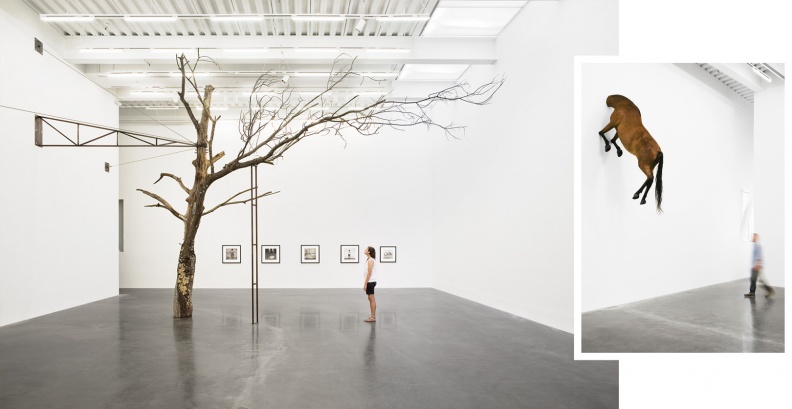 Installation views from “After Nature” (2008) in the Fourth Floor gallery
Installation views from “After Nature” (2008) in the Fourth Floor gallery
At nearly 3,000 square feet, the Fourth Floor gallery has the smallest footprint of the Museum’s main galleries, but is also the tallest. Ceilings here are twenty-four feet in height. The space is also graced with a southern skylight that permits natural light of varied qualities to wash through the galleries during the day. This can be controlled, as in all of the building’s galleries, through a system of adjustable panels beneath the glass. In the galleries, the steel of the architecture is exposed—the diagonal structural beams of the exterior, rendered white with their intumescent fireproofing paint, appear at interludes. “We want the building to show what it is,” SANAA has stated. “This openness is consistent with the openness of the New Museum.”
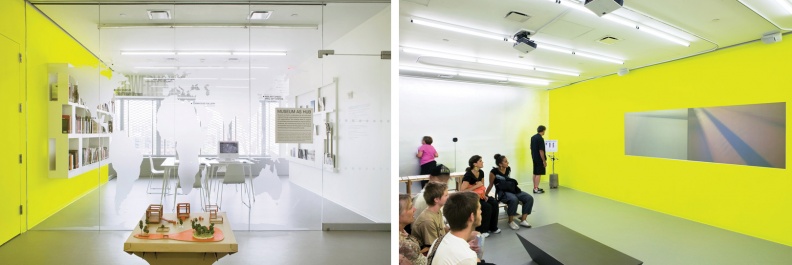 Installation views from “Museum as Hub: In and Out of Context” (2009-10) on the Fifth Floor
Installation views from “Museum as Hub: In and Out of Context” (2009-10) on the Fifth Floor
The outer structural columns become increasingly exposed above the fourth floor in the less public levels of the building. The Fifth Floor houses the institution’s education center, with classroom spaces, a Resource Center, a space for the institution’s revolutionary Museum As Hub intra-institutional outreach program, and a video editing room. On the sixth floor are the staff offices, staff kitchen, restrooms, and meeting spaces. Here, operable windows wrap the space on two sides and sliding polycarbonate panels provide privacy.
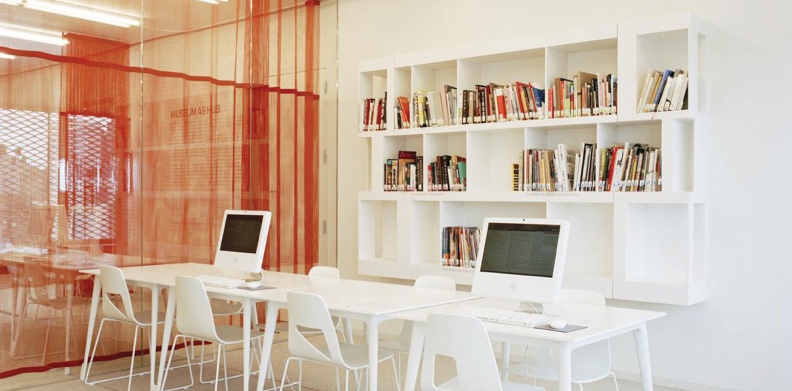 Fifth Floor Resource Center
Fifth Floor Resource Center
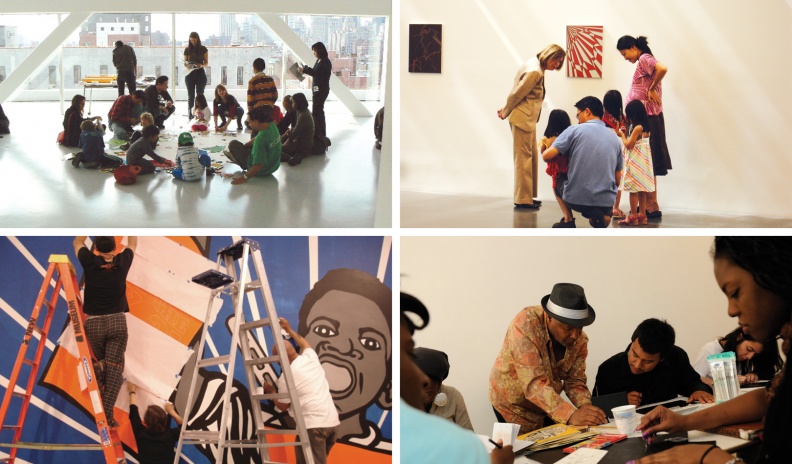 Top: First Saturdays for Families offers free, hands-on programming for families with children every month. Bottom: Artists Emory Douglas and Rigo 23 paint a mural as part of the exhibition “Emory Douglas: Black Panther” (2009). Later, high school students work with Douglas to plan and execute a community mural
Top: First Saturdays for Families offers free, hands-on programming for families with children every month. Bottom: Artists Emory Douglas and Rigo 23 paint a mural as part of the exhibition “Emory Douglas: Black Panther” (2009). Later, high school students work with Douglas to plan and execute a community mural
On the seventh floor of the building, the New Museum offers the public one of the most arresting public spaces in downtown Manhattan: an eleven-foot-high, nearly 2,000-square-foot multipurpose space for events and special programs. The Sky Room features two walls of floor-to-ceiling glass and is surrounded by panoramic vistas of the city from an outdoor terrace that runs without interruption around the east and south sides of the building.
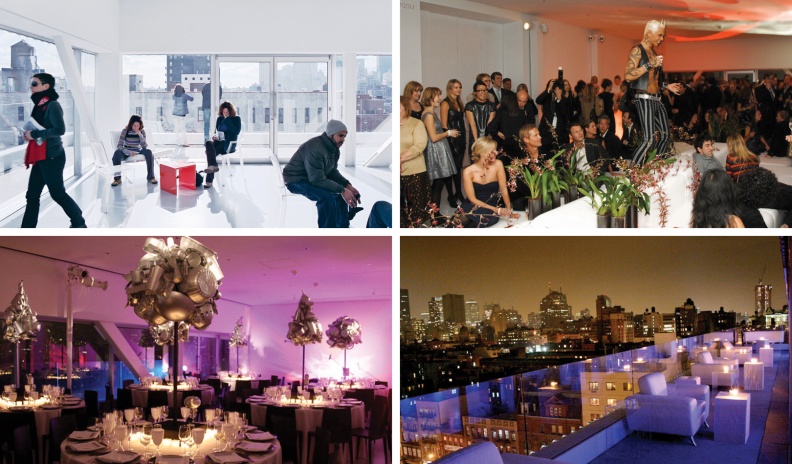 Views of the Sky Room. Bottom right: Sky Room terrace
Views of the Sky Room. Bottom right: Sky Room terrace
An enclosed area on the New Museum’s roof houses mechanical support and water towers.
Reflecting upon the completed building, five years from initial conception to completion, SANAA has stated: “The new New Museum building is both part of SANAA and the New Museum. In the time that we have been together, both have changed very much. In some ways we are both bigger, more relaxed, but still always hoping to explore and find new things. The New Museum is intriguing because it is always trying to find itself and we hope that continues to be so. Our building is an attempt to express that adventurousness and freedom.”
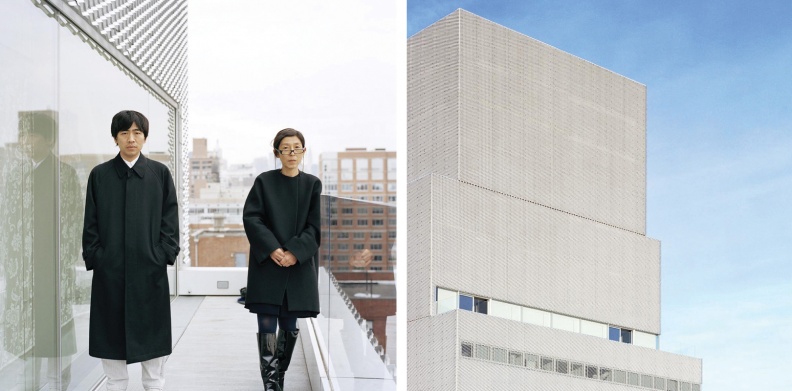
Campaign
The New Museum gratefully acknowledges the many individuals, foundations, corporations, and government agencies for their tremendously generous support of our building campaign. These names are displayed on our permanent donor wall in the Lobby of the New Museum with our sincerest gratitude.
The new New Museum is made possible by a grant from the Lower Manhattan Development Corporation, which is funded through Community Development Block Grants from the U.S. Department of Housing and Urban Development.
New York State Governor Eliot R. Spitzer
New York City Mayor Michael R. Bloomberg
LMDC Chairman Avi Shick
LMDC President David Emil
City of New York, Mayor Michael R. Bloomberg
New York City Department of Cultural Affairs, Commissioner Kate D. Levin
New York City Department of Design and Construction, Commissioner David J. Burney, AIA
New York City Council, Speaker Christine C. Quinn